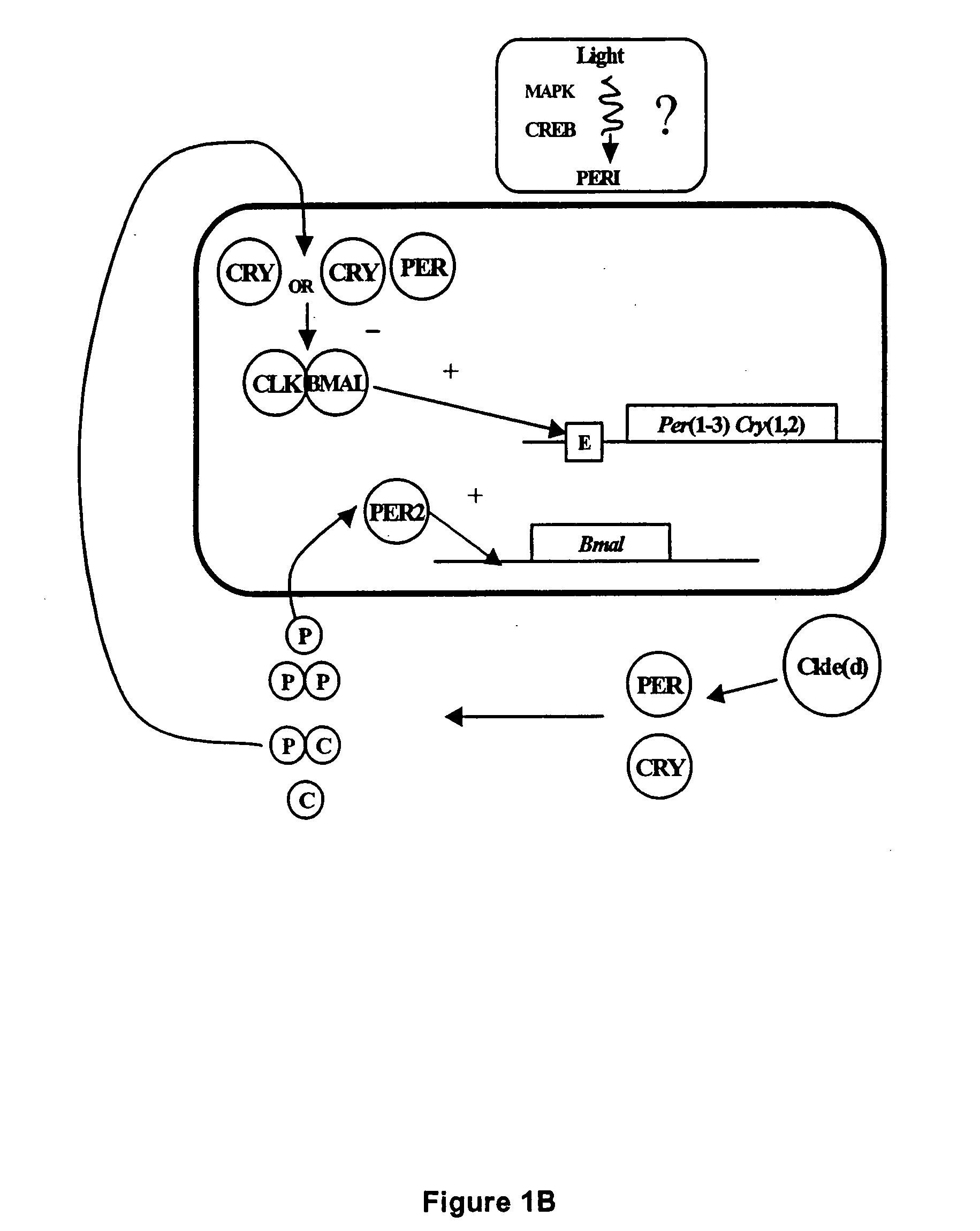Advanced sleep phase syndrome gen in humans
a sleep phase syndrome and gen technology, applied in the field of advanced sleep phase syndrome gen in humans, can solve the problems of significant sleep deprivation, adversely affecting driving and work safety, social function, school performance, and overall quality of life of sleep phase-delayed individuals, and achieves the effects of improving sleep quality, improving sleep quality, and improving sleep quality
- Summary
- Abstract
- Description
- Claims
- Application Information
AI Technical Summary
Benefits of technology
Problems solved by technology
Method used
Image
Examples
example 1
Discovery of and Characterization of an FASPS Family
[0073] The first ASPS patient presented to a sleep center with disabling early evening sleepiness and early morning awakening. Because the patient recognized a similar trait in some family members, consenting relatives from her extended family were evaluated. A structured interview with each participant focused on the underlying preferred sleep schedule in the absence of psychosocial factors that would delay or advance sleep phase. Individuals were considered `affected` if they described a life-long, stable pattern of early sleep onset and offset and met strict classification criteria. Jones, C. R., et al., Familial advanced sleep-phase syndrome. A short-period circadian rhythm variant in humans, Nat. Med., 1999, 5(9):1062-5. The Horne-stberg questionnaire, a validated measure of "morning lark" vs. "night owl" tendency, was administered to each subject. Horne, J. A. and O. stberg, A self-assessment questionnaire to determine mornin...
example 2
A Study of Physiologic Parameters of FASPS Individuals
[0075] Six FASPS subjects (ages 20-69, average 37.+-.18 years) were gender- and age-matched (.+-.6 years) to six unrelated controls on conventional sleep-wake schedules for an inpatient study. All participants underwent a medical history and physical exam and were found to be generally healthy. The Beck Depression Inventory (BDI) was administered with scores from both FASPS and control groups falling into the range of "minimal depression." Beck, A. T., The Beck Depression Inventory, 1978, The Psychological Corporation: Harcourt Brace Jovanovich.
[0076] The 12 inpatient subjects were admitted in the early afternoon for two consecutive nights of polysomnographic (PSG) assessment of sleep phase and sleep quality followed each morning by a Multiple Sleep Latency Test (MSLT). The MSLT estimates sleepiness by measuring the latency to sleep onset in multiple nap trials during the day. The PSG and MSLT recordings were performed and scored...
example 3
Free Running Period Measurement
[0079] One 69-year-old subject was studied in a time isolation facility to determine the intrinsic period of her circadian clock. Immediately following a three-day entrainment period on a 24-hour sleep / wake schedule, she was studied for 18 days in a laboratory apartment without any cues to time of day. The subject was instructed to eat and sleep whenever she felt inclined, with the exception that she was requested not to take naps. During her waking hours, the subject was permitted to carry out leisure activities in 150-lux ambient light. EEG and body core temperature were recorded continuously throughout her 3-week laboratory stay. The sleep and wakefulness scoring by standard criteria demonstrated normal sleep architecture and sleep quality. Rechtschaffen, A. and A. Kales, A manual of standardized terminology, techniques and scoring system for sleep stages of human subjects, 1968, Los Angeles: UCLA Brain Information Service / Brain Research Institute. ...
PUM
| Property | Measurement | Unit |
|---|---|---|
| Fraction | aaaaa | aaaaa |
| Fraction | aaaaa | aaaaa |
| Fraction | aaaaa | aaaaa |
Abstract
Description
Claims
Application Information
 Login to View More
Login to View More - R&D
- Intellectual Property
- Life Sciences
- Materials
- Tech Scout
- Unparalleled Data Quality
- Higher Quality Content
- 60% Fewer Hallucinations
Browse by: Latest US Patents, China's latest patents, Technical Efficacy Thesaurus, Application Domain, Technology Topic, Popular Technical Reports.
© 2025 PatSnap. All rights reserved.Legal|Privacy policy|Modern Slavery Act Transparency Statement|Sitemap|About US| Contact US: help@patsnap.com



